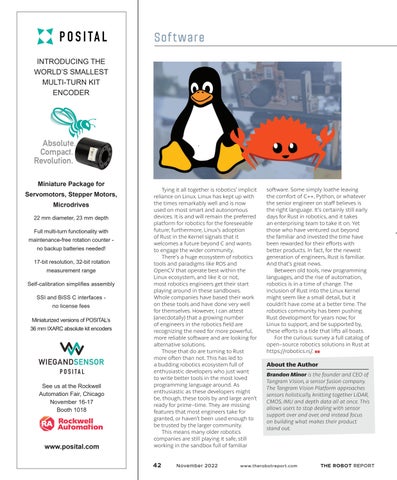Software INTRODUCING THE WORLD’S SMALLEST MULTI-TURN KIT ENCODER
Miniature Package for Servomotors, Stepper Motors, Microdrives 22 mm diameter, 23 mm depth Full multi-turn functionality with maintenance-free rotation counter no backup batteries needed! 17-bit resolution, 32-bit rotation measurement range Self-calibration simplifies assembly SSI and BiSS C interfaces no license fees Miniaturized versions of POSITAL’s 36 mm IXARC absolute kit encoders
See us at the Rockwell Automation Fair, Chicago November 16-17 Booth 1018
www.posital.com
Tying it all together is robotics’ implicit reliance on Linux. Linux has kept up with the times remarkably well and is now used on most smart and autonomous devices. It is and will remain the preferred platform for robotics for the foreseeable future; furthermore, Linux’s adoption of Rust in the Kernel signals that it welcomes a future beyond C and wants to engage the wider community. There’s a huge ecosystem of robotics tools and paradigms like ROS and OpenCV that operate best within the Linux ecosystem, and like it or not, most robotics engineers get their start playing around in these sandboxes. Whole companies have based their work on these tools and have done very well for themselves. However, I can attest (anecdotally) that a growing number of engineers in the robotics field are recognizing the need for more powerful, more reliable so ware and are looking for alternative solutions. Those that do are turning to Rust more o en than not. This has led to a budding robotics ecosystem full of enthusiastic developers who just want to write better tools in the most loved programming language around. As enthusiastic as these developers might be, though, these tools by and large aren’t ready for prime-time. They are missing features that most engineers take for granted, or haven’t been used enough to be trusted by the larger community. This means many older robotics companies are still playing it safe, still working in the sandbox full of familiar
42
Linux-Rust_11-22_Vs2.indd 42
November 2022
so ware. Some simply loathe leaving the comfort of C++, Python, or whatever the senior engineer on staff believes is the right language. It’s certainly still early days for Rust in robotics, and it takes an enterprising team to take it on. Yet those who have ventured out beyond the familiar and invested the time have been rewarded for their efforts with better products. In fact, for the newest generation of engineers, Rust is familiar. And that’s great news. Between old tools, new programming languages, and the rise of automation, robotics is in a time of change. The inclusion of Rust into the Linux Kernel might seem like a small detail, but it couldn’t have come at a better time. The robotics community has been pushing Rust development for years now; for Linux to support, and be supported by, these efforts is a tide that li s all boats. For the curious: survey a full catalog of open-source robotics solutions in Rust at https://robotics.rs/. RR
About the Author Brandon Minor is the founder and CEO of Tangram Vision, a sensor fusion company. The Tangram Vision Platform approaches sensors holistically, knitting together LiDAR, CMOS, IMU and depth data all at once. This allows users to stop dealing with sensor support over and over, and instead focus on building what makes their product stand out.
www.therobotreport.com
THE ROBOT REPORT
11/4/22 7:52 AM
